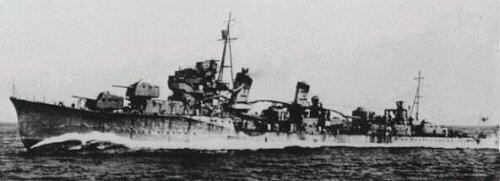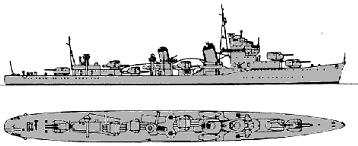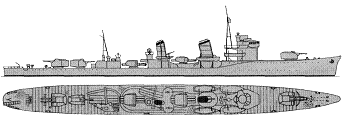
NAVYPEDIA
 Support the project with paypal
Support the project with paypal
Photo

Nenohi 1933
Ships
| Name | No | Yard No | Builder | Laid down | Launched | Comp | Fate |
|---|---|---|---|---|---|---|---|
| 初春 [Hatsuharu] | Sasebo K K | 5/1931 | 27.2.1933 | 9.1933 | sunk 13.11.1944 | ||
| 子日 [Nenohi] | Uraga, Tokyo | 12/1931 | 22.12.1932 | 9/1933 | sunk 4.7.1942 | ||
| 初霜 [Hatsushimo] | Uraga, Tokyo | 1/1933 | 4.11.1933 | 9/1934 | sunk 30.7.1945 | ||
| 若葉 [Wakaba] | Sasebo K K | 12/1931 | 18.3.1934 | 10/1934 | sunk 24.10.1944 | ||
| 夕暮 [Yugure] | Maizuru K K | 4/1933 | 6.5.1934 | 3/1935 | sunk 20.7.1943 | ||
| 有明 [Ariake] | Kawasaki, Kobe | 1/1933 | 23.9.1934 | 3/1935 | sunk 28.7.1943 |
Technical data
| Displacement standard, t | Hatsuharu, Nenohi: 1490 others: 1715 |
|---|---|
| Displacement full, t | Hatsuharu, Nenohi: 1900 others: 2240 |
| Length, m | 103.5 pp 105.5 wl 109.5 oa |
| Breadth, m | Hatsuharu, Nenohi, Hatsushimo, Wakaba: 10.0 Yugure, Ariake: 10.3 |
| Draught, m | 3.03 |
| No of shafts | 2 |
| Machinery | 2 sets Kampon geared steam turbines, 3 Kampon boilers |
| Power, h. p. | 42000 |
| Max speed, kts | Hatsuharu, Nenohi: 36.5 others: 33.3 |
| Fuel, t | oil 500 |
| Endurance, nm(kts) | 6000(15) |
| Armament | Hatsuharu, Nenohi: 2 x 2 - 127/50 3-shiki, 1 x 1 - 127/50 3-shiki, 2 x 1 - 13.2/76, 3 x 3 - 610 TT (15), 2 DCT (14) others: 2 x 2 - 127/50 3-shiki, 1 x 1 - 127/50 3-shiki, 2 x 1 - 13.2/76, 2 x 3 - 610 TT (12), 2 DCT (14) |
| Electronic equipment | 93-shiki sonar |
| Complement | 200 |
Standard scale images

Hatsuharu 1933

Hatsushimo 1943

Hatsuharu 1941
Graphics
Project history
Built under 1st Supplementary Programme of 1931. Design was made taking into account of the limitations of the London Naval conference of 1930, on admissible standard displacement of destroyer (1500t). Having shown a rare ingenuity and having paid special attention to the weight control, Japanese shipbuilders have created the design in which in "contractual" displacement it was possible to "squeeze" the armament which practically are not yielding fitted on larger Fubuki class ships. Hatsuharu class destroyers were equipped with the lightened 127mm mounts (max elevation angle was 55°), the number of guns was shrank, in comparison with Fubuki, from six to five. TTs of new model for the first time have received a power drive. Fast recharge system allowed to change torpedoes in TT for 17 seconds. The arrangement of TTs became interesting feature of the project: No1 and No3 mounts have been a little displaced from a centre line: former to port, latter to starboard. It has been made for convenience of recharge. For the same reason the second funnel has appeared is displaced to starboard. Destroyers of this class became the first in the IJN, received the oxygen version of 610mm torpedoes.
Though on a drawings the new ships looked terribly, lacks at the design it has appeared more than advantages. Despite all reasonable efforts, displacement has exceeded the established norms: standard it has appeared all on 260t less, than at the ships of "special type". Outwardly the first completed destroyers of Hatsuharu class looked even more massive than predecessors as had larger fore superstructure.
Fore No1 (twin) and 2 (single) mounts placed on a forecastle under superfiring scheme: for the first time on the Japanese destroyers. Third torpedo mount was on aft shelterdeck. In a combination to the narrow hull such distribution of weights called a ship stability into question though after the commission of lead destroyer it recognised as satisfactory. Before catastrophe of Tomozuru only Hatsuharu and Nenohi were completed, then the question on their stability has been reconsidered.
Other two ships were in a high degree of readiness, and remaining in smaller. Series building have suspended, and project have completely redesigned. In 1935-1937 Hatsuharu and Nenohi, Hatsushimo and Wakaba have undergone to considerable alterations. A construction of fore part have thoroughly changed. Height of superstructures, funnels and masts have moderated, and 84t of solid ballast was laid into hold. The aft superstructure has been altered and moderated in sizes to exempt space for No2 gun mount transferred from fore superstructure and placed "a back to a back" with No3 mount. Aft TT was removed. Standard displacement has increased from 1490 to 1715t, as consequence speed has fallen to 33.3kts. Last two ships, Yugure and Ariake, were completed already in that kind what others have received after reconstruction. As at the moment of change of the design they were in a low phase of availability, their hulls managed to be made more widely on 0.34m.
Modernizations
1934 - 1935, Hatsuharu, Nenohi: 84t of solid ballast were added, superstructures, funnels and masts were shortened, 1 x 3 TT was removed and single gunhouse was moved to stern. Data was as later ships of class.
1939 - 1940, all: - 2 x 1 - 13.2/76; + 2 x 2 - 25/60 96-shiki
1942 - 1943, all but Nenohi: - 1 x 1 - 127/50, spare torpedoes; + 2 x 3 - 25/60 96-shiki, 4 x 1 - 13.2/76, 2 DCT (36 totally)
1944, all survived: - 1 x 2 - 25/60; + 1 x 3 - 25/60 96-shiki, 2 x 1 - 25/60 96-shiki
late 1944, all survived: + 8 x 1 - 25/60 96-shiki
1944-1945, all survived: + 2-shiki 2-go, 3-shiki 1-go radars
1944-1945, some survived: + E-27 ECM suite
Naval service
Nenohi 4.7.1942 was sunk off Aleutian by US submarine Triton. Yugure 16.5.1943 was damaged at Kavieng by US submarine Grayback, 20.7.1943 she was sunk in Vella-Lavella Bay (New Georgia) by US Marine Corps aircraft. Ariake 27.7.1943 ran aground at Cape Gloucester (New Britain) and was destroyed next day by US Army aircraft. Wakaba 24.10.1944 at Panay (Philippines) was sunk by US carrier aircraft. Hatsuharu 13.11.1944 was sunk in Manila Bay by US carrier aircraft. Hatsushimo 30.7.1945 was lost on a mine NW off Maizuru.
 HOME
HOME FIGHTING SHIPS OF THE WORLD
FIGHTING SHIPS OF THE WORLD JAPAN
JAPAN TORPEDO SHIPS
TORPEDO SHIPS HATSUHARU destroyers (1933 - 1935)
HATSUHARU destroyers (1933 - 1935)
